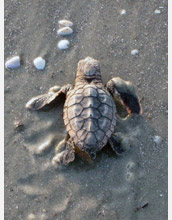Multimedia Gallery
Sea Turtle Locomotion
A hatchling loggerhead (Caretta caretta) sea turtle heads toward the ocean after emerging from its nest. After climbing out of their underground nest, the baby turtles must quickly traverse a variety of terrains for several hundred feet to reach the ocean.
The turtles were the focus of a study by researchers at the Georgia Institute of Technology, in collaboration with the Georgia Sea Turtle Center, to see how hatchlings use their limbs to move quickly on loose sand and hard ground to reach the ocean. Although the turtles' limbs are adapted for a life at sea, their flippers enable excellent mobility over dune grass, rigid obstacles and sand of varying compaction and moisture content.
More about this Image
Georgia Tech biology graduate student Nicole Mazouchova and research technician Andrei Savu studied the movement of sea turtle hatchlings at Jekyll Island on the coast of Georgia. Mazouchova and Savu worked from a mobile laboratory that contained a nearly three-foot-long trackway filled with dry Jekyll Island sand. The density of the sand was controlled by blowing pulses of air through holes in the trackway bottom, thereby elevating the granules and causing them to settle into a loosely packed solid state.
In addition to sand, the researchers also tested the turtle's mobility on hard surfaces using a sandpaper-covered board that was placed on top of the sand. Two high-speed cameras were used to record the movements of the hatchlings along the trackway and the recordings showed that the turtles will alter their locomotion depending on the surface. For example, on the rigid sandpaper surface, the turtles anchored a claw located on their wrists into the sandpaper and propelled themselves forward. During the thrusting process, one of the turtle's shoulders rotated toward its body and its wrist did not bend, keeping the limb fully extended. In contrast, on loosely packed sand, pressure from the thin edge of one of the turtle's flippers caused the limb to penetrate into the sand. The turtle's shoulder then rotated as the flipper penetrated until the flipper was perpendicular to the surface and the turtle's body lifted from the surface. This research shows that the turtles can traverse a variety of terrains, whether hard-packed sand or loose sand.
The researchers assumed the turtles would perform best on rigid ground because it would not give way under their flippers, but their experiments showed that while the turtles' average speed on sand was reduced by 28 percent relative to hard ground, their maximal speeds were the same for both surfaces.
In addition to field studies, Daniel Goldman, an assistant professor at the Georgia Tech School of Physics, and physics graduate student Nick Gravish designed an artificial flipper system in the lab consisting of a thin aluminum plate that was inserted into and dragged along the trackway filled with Jekyll Island sand. During the dragging procedure, calibrated strain gauges mounted on the flipper provided force measurements.
"Our model revealed that a major challenge for rapid locomotion of hatchling sea turtles on sand is the balance between high speed, which requires large inertial forces, and the potential for failure through fluidization of the sand," explained Goldman. "We believe that the turtles modulate the amount of force they use to push into the sand so that it remains below the force required for the ground to break apart and become fluid-like."
This research could ultimately help engineers build robots that could travel across complex environments. Goldman notes that this could be particularly valuable for roboticists when considering the number of appendage features necessary for a robot to move effectively on land and whether they can design a robot with a flat mitt and a claw, similar to the turtles.
This research was supported in part by National Science Foundation grant CMMI 08-25480. Further information about the Georgia Sea Turtle Center, which rehabilitates sea turtles and offers research and education programs, among other things, is available Here. (Date of Image: 2008-2009)
Credit: GSTC Turtle Patrol
Images and other media in the National Science Foundation Multimedia Gallery are available for use in print and electronic material by NSF employees, members of the media, university staff, teachers and the general public. All media in the gallery are intended for personal, educational and nonprofit/non-commercial use only.
Images credited to the National Science Foundation, a federal agency, are in the public domain. The images were created by employees of the United States Government as part of their official duties or prepared by contractors as "works for hire" for NSF. You may freely use NSF-credited images and, at your discretion, credit NSF with a "Courtesy: National Science Foundation" notation.
Additional information about general usage can be found in Conditions.
Also Available:
Download the high-resolution JPG version of the image. (538 KB)
Use your mouse to right-click (Mac users may need to Ctrl-click) the link above and choose the option that will save the file or target to your computer.

